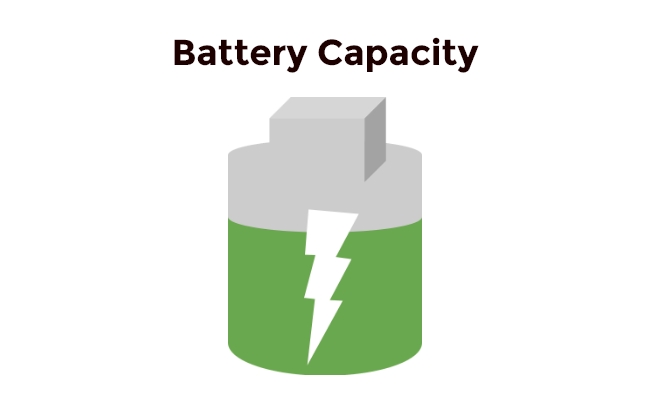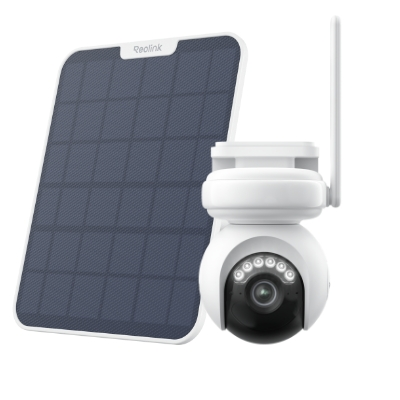Understanding Battery Capacity: A Comprehensive Guide

The working hours of battery-powered security cameras depend on their battery capacity. But common people don’t have an idea of what it is and how to calculate it.
In this article, we will explain battery capacity in simple words. We will highlight the factors affecting battery power and tips to maximize battery capacity and lifespan. We will also discuss the step-by-step process of calculating the battery capacity.
What is Battery Capacity?
The energy that a battery is capable of storing is called Battery Capacity. Every battery has a limited capacity, and it decides how long it can power a certain device, be it a security camera, mobile phone, laptop, etc.
The battery capacity is measured in Amper Hours (Ah). It is the primary unit and is used for larger batteries. The small batteries used in devices do not have that much capacity, which is the reason the mentioned unit is mAh (milli ampere hour).
If the battery capacity is 500mAh, it means the battery can supply 500mA to any device for one hour. That said, if the device consumes 100mA every hour, the battery will last for four hours. By looking at the battery capacity and having an idea of the device's energy requirement, you can predict how long the battery can last.
Factors to Affect Battery Capacity
The following factors have a significant impact on battery capacity.
Battery Chemistry and Type
The primary factor that has a massive impact on battery capacity is its type. You will find different battery technologies in the market, such as lead-acid batteries and lithium-ion batteries. All these have a distinct chemistry and working process. You have to choose the right battery type based on size, energy density, cycle life, etc.
Temperature and Environmental Conditions
Temperature and environmental conditions also affect the battery capacity. In extreme conditions, such as snow or high temperatures, the battery capacity is reduced. That’s the reason you will notice the optimal temperature range on battery-powered devices.
Aging and Degradation
Over time, batteries degrade. Their cells, electrodes, plates, and other components age. Their capacity reduces as they degrade. Suppose a battery has a capacity of 5000mAh. It won’t be able to offer the rated capacity after one year of use. Your battery capacity could be 80% of the rated.
Charging Cycles and Depth of Discharge
If you continuously use your battery and discharge it quickly, it will have a high discharge rate, which will decrease the battery capacity over time. There are limited charging cycles for each battery, and it’s up to you whether you complete those cycles as quickly as you can or use it at a slower rate to increase the capacity for a longer period.
How to Calculate Battery Capacity?
There are different ways to measure battery capacity. Let’s look at the simplest one.
For the measurement, you need a constant current load, which means its current shouldn’t change over time. You can take an incandescent bulb. It’s a resistive load with a constant current.
Connect the battery to the load and turn it on. Now, note the time required by the battery to discharge completely. You can also note the time when it reaches a specific voltage.
Once you have the time, you can calculate the capacity by multiplying time in hours with the constant current.
Suppose the battery lasted for 5 five hours and the constant current was 1,000mA. Thus, the battery capacity will be:
- Battery Capacity = Constant Current x Time
- Battery Capacity = 1,000 x 5
- Battery Capacity = 5,000mAh
Tips for Maximizing the Battery Capacity and Lifespan
- For optimal battery life, charge the battery before it completely discharges. Recharge it when it is around 20%.
- Do not overcharge or charge it completely. Charge up to 95% for a longer lifespan.
- Keep your batteries in optimal temperatures. Check the specifications and ensure optimal conditions.
- When you want to store the battery, it should be about 50-60% charged to prevent 100% drainage.
- Avoid deep discharging. Try to consume the energy slowly to prevent quick degradation.
- Keep an eye on the battery's health. Use applications to monitor the life, charging, voltage, and other metrics.
High Capacity Battery Power Security Camera
Reolink Altas PT Ultra
The Altas PT Ultra is a battery-powered security camera built for longer-lasting performance. With a 20000mAh battery, it offers double the capacity of similar models, providing up to 12 hours of usage per day and up to 8 days of continuous recording. The efficient design extends its usage life, making it a reliable choice for continuous monitoring. It can also be charged automatically using a solar panel for added convenience.
This camera delivers ultra-clear True 4K 8MP resolution, capturing fine details with excellent precision. Equipped with a pixel-dense 4mm lens, the Altas PT Ultra provides exceptional clarity. Its pan and tilt features allow it to cover a broader area, while the Wi-Fi 6 technology ensures fast and stable connections, making it perfect for homes, businesses, or outdoor monitoring.
Industry-leading 4K Continuous Recording Battery Camera
4K UHD Continuous Recording; ColorX Night Vision; Pan & Tilt; Automatic Tracking; All Recordings Stored Locally.
Reolink Argus 4 Pro
Argus 4 Pro is a battery-powered Wi-Fi security camera that ensures longer battery life. It lasts 30% more because of the efficient design, so you get 12 days extra standby time. It can also be charged automatically using a small solar panel.
It’s a 4K camera that captures fine details with excellent clarity. It has Reolink ColorX technology that offers true colors during the day and night. It covers a wider area through its dual lenses and records a 180⁰ wide view. Its Wi-Fi 6 technology ensures a fast and stable connection that gives you peace of mind. It’s an ideal camera for homes, offices, and commercial properties.
4k 180° Wire-free Color Night Vision Camera
4K UHD 180° Blindspot-free View; Color Vision Day and Night; 30% More Battery Life; Dual-band Wi-Fi 6; Smart detection.
FAQs
1. What does 5000mAh battery capacity mean?
It means the battery can provide 5000mA for one hour continuously. If your device consumes 100mA per hour, it means the battery will last 50 hours.
2. What is a good battery capacity?
There is no straight answer to the question, as the battery capacity is selected according to the load. A 5000mAh battery is a good option for a smartphone, but I am not a fan. Ideally, a good battery capacity should be enough to power the required load for the required time.
3. Does higher mAh mean more power?
Yes, higher mAh means the battery capacity is high. It stores more energy and can power the device for a longer duration compared to a lower mAh battery.
Conclusion
Battery capacity is an important specification that indicates how long the battery can power a device. It is mentioned in almost every battery-powered product. Users need to check the battery capacity to have an idea of the battery life. We have explained how you can calculate battery capacity and the factors that affect it. Consider the tips we have shared to maximize the battery capacity and enjoy longer hours.
Search
Subscribe for the Latest Updates
Security insights & offers right into your inbox


